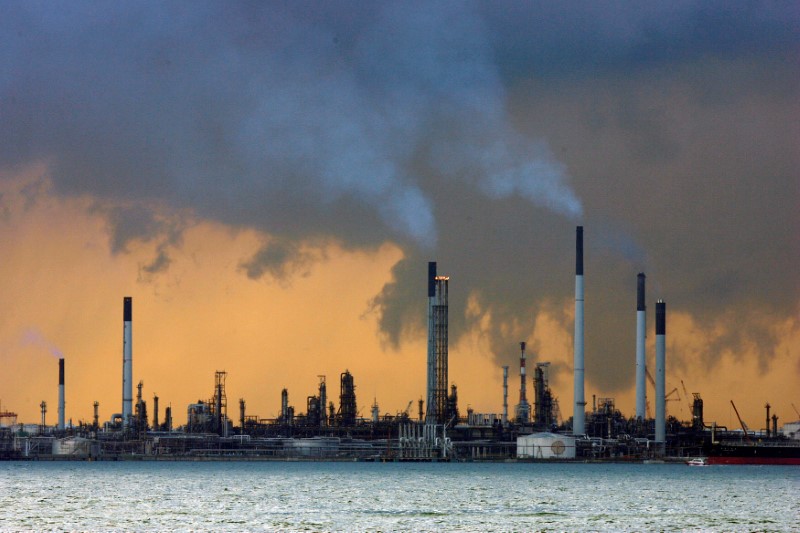TOKYO, July 19 (Reuters) - Oil prices rose more than 1% on
Friday after the U.S. Navy destroyed an Iranian drone in the
Strait of Hormuz, a major chokepoint for global crude flows,
again raising tensions in the Middle East.
Brent crude LCOc1 futures were up 82 cents, or 1.3%, at
$62.75 by 0100 GMT. They closed down 2.7% on Thursday, falling
for a fourth day.
West Texas Intermediate crude CLc1 futures firmed 61
cents, or 1.1%, at 55.91. They fell 2.6% in the previous
session.
The United States said on Thursday that a U.S. Navy ship had
"destroyed" an Iranian drone in the Strait of Hormuz after the
aircraft threatened the vessel, but Iran said it had no
information about losing a drone. The move comes after Britain pledged to defend its shipping
interests in the region, while U.S. Central Command chief
General Kenneth McKenzie said the United States would work
"aggressively" to enable free passage after recent attacks on
oil tankers in the Gulf. Still, the longer-term outlook for oil has grown
increasingly bearish.
The International Energy Agency (IEA) is reducing its 2019
oil demand forecast due to a slowing global economy amid a
U.S.-China trade spat, its executive director said on Thursday.
The IEA is revising its 2019 global oil demand growth
forecast to 1.1 million barrels per day (bpd) and may cut it
again if the global economy and especially China shows further
weakness, Fatih Birol said.
"China is experiencing its slowest economic growth in the
last three decades, so are some of the advanced economies ... if
the global economy performs even poorer than we assume, then we
may even look at our numbers once again in the next months to
come," Birol told Reuters in an interview. Last year, the IEA predicted that 2019 oil demand would grow
by 1.5 million bpd but had already cut the growth forecast to
1.2 million bpd in June this year.
Speculators have exited options positions that could have
provided exposure to higher prices in the next several years,
market participants said on Thursday.
U.S. offshore oil and gas production has continued to return
to service since Hurricane Barry passed through the Gulf of
Mexico last week, triggering platform evacuations and output
cuts.
Royal Dutch Shell, a top Gulf producer, said Wednesday it
had resumed about 80% of its average daily production in the
region.
- English (USA)
- English (UK)
- English (India)
- English (Canada)
- English (Australia)
- English (South Africa)
- English (Philippines)
- Deutsch
- Español (España)
- Español (México)
- Français
- Italiano
- Nederlands
- Português (Portugal)
- Polski
- Português (Brasil)
- Русский
- Türkçe
- العربية
- Ελληνικά
- Svenska
- Suomi
- עברית
- 日本語
- 한국어
- 简体中文
- 繁體中文
- Bahasa Indonesia
- Bahasa Melayu
- ไทย
- Tiếng Việt
- हिंदी
Oil rises after U.S. Navy destroys Iranian drone

Latest comments
Install Our App
Risk Disclosure: Trading in financial instruments and/or cryptocurrencies involves high risks including the risk of losing some, or all, of your investment amount, and may not be suitable for all investors. Prices of cryptocurrencies are extremely volatile and may be affected by external factors such as financial, regulatory or political events. Trading on margin increases the financial risks.
Before deciding to trade in financial instrument or cryptocurrencies you should be fully informed of the risks and costs associated with trading the financial markets, carefully consider your investment objectives, level of experience, and risk appetite, and seek professional advice where needed.
Fusion Media would like to remind you that the data contained in this website is not necessarily real-time nor accurate. The data and prices on the website are not necessarily provided by any market or exchange, but may be provided by market makers, and so prices may not be accurate and may differ from the actual price at any given market, meaning prices are indicative and not appropriate for trading purposes. Fusion Media and any provider of the data contained in this website will not accept liability for any loss or damage as a result of your trading, or your reliance on the information contained within this website.
It is prohibited to use, store, reproduce, display, modify, transmit or distribute the data contained in this website without the explicit prior written permission of Fusion Media and/or the data provider. All intellectual property rights are reserved by the providers and/or the exchange providing the data contained in this website.
Fusion Media may be compensated by the advertisers that appear on the website, based on your interaction with the advertisements or advertisers
Before deciding to trade in financial instrument or cryptocurrencies you should be fully informed of the risks and costs associated with trading the financial markets, carefully consider your investment objectives, level of experience, and risk appetite, and seek professional advice where needed.
Fusion Media would like to remind you that the data contained in this website is not necessarily real-time nor accurate. The data and prices on the website are not necessarily provided by any market or exchange, but may be provided by market makers, and so prices may not be accurate and may differ from the actual price at any given market, meaning prices are indicative and not appropriate for trading purposes. Fusion Media and any provider of the data contained in this website will not accept liability for any loss or damage as a result of your trading, or your reliance on the information contained within this website.
It is prohibited to use, store, reproduce, display, modify, transmit or distribute the data contained in this website without the explicit prior written permission of Fusion Media and/or the data provider. All intellectual property rights are reserved by the providers and/or the exchange providing the data contained in this website.
Fusion Media may be compensated by the advertisers that appear on the website, based on your interaction with the advertisements or advertisers
© 2007-2025 - Fusion Media Limited. All Rights Reserved.